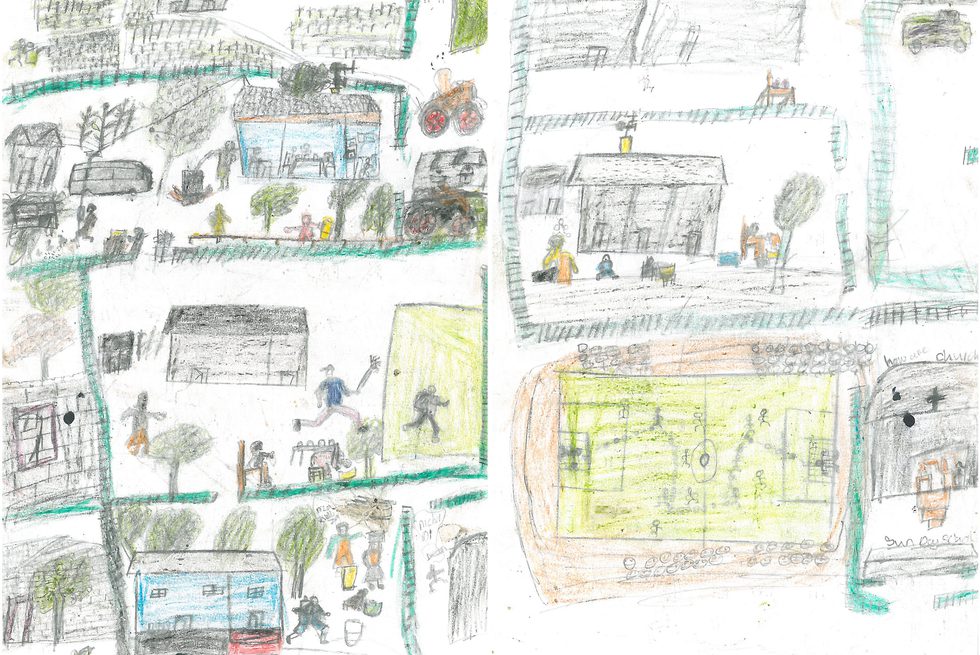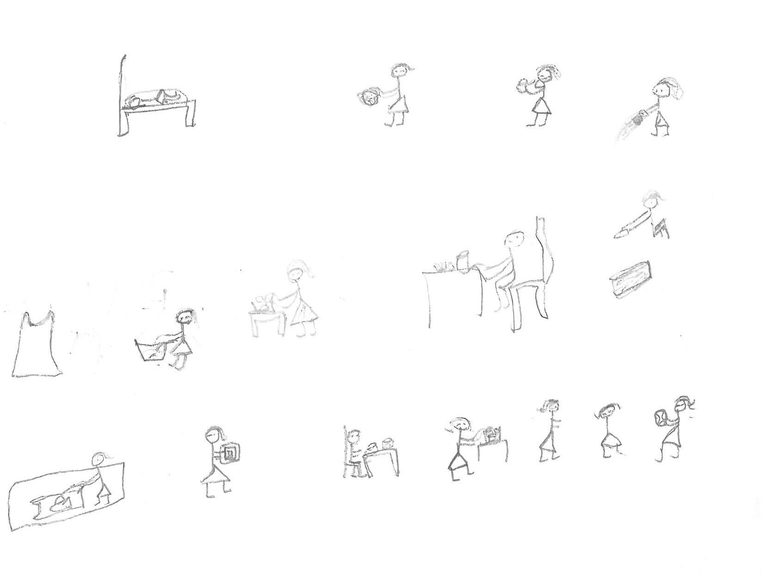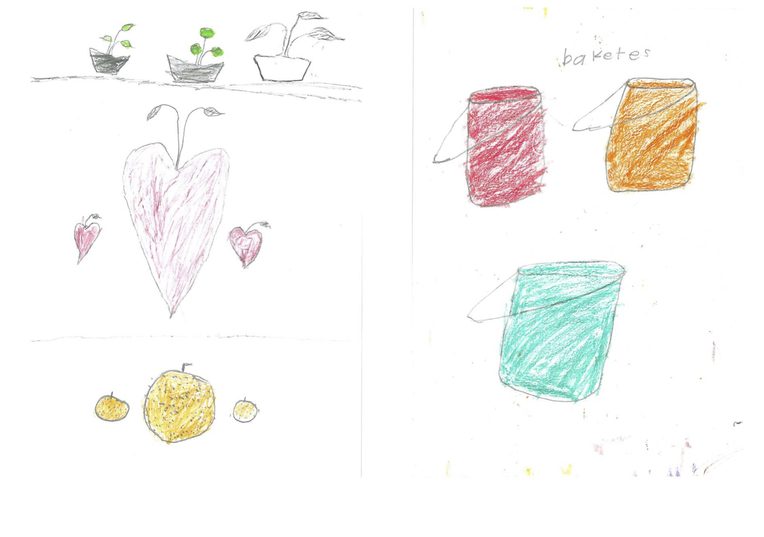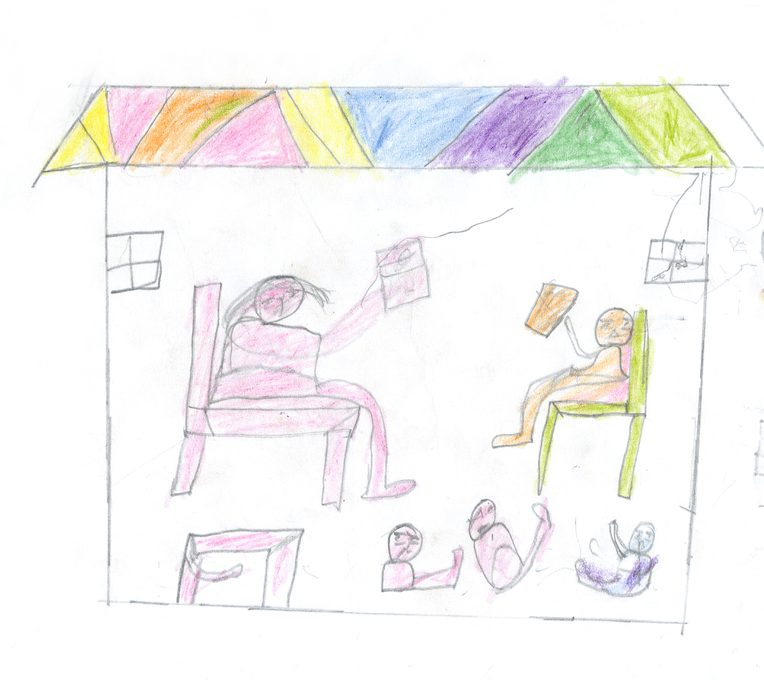
This post builds on the research article “Zambian Children’s Imaginal Caring: On Fantasy, Play, and Anticipation in an Epidemic,” which was published in the May 2019 issue of the Society’s peer-reviewed journal, Cultural Anthropology.
The pedagogical activities in this post encourage students to engage with Jean Hunleth’s concept of imaginal caring and the creative promises of drawing as an ethnographic method within and beyond the category of “childhood.” Through in-class activities and discussions, we invite students to engage seriously with complex and fantastical practices of imaginal caring by cultivating their own drawing practice and analyzing their own drawings, the drawings of children, and the drawings of their peers. This post includes a discussion with Hunleth about children's drawings as an archive, drawings as ethnographic representations, and drawing as a multimodal anthropological method.
Learning Goals
The following classroom activities and discussion topics ask students to reflect on the concepts of “care” and “imaginal caring" as well as engage in drawing as a creative practice, ethnographic method, form of care, and as “text” or aesthetic material. At the end of these exercises, students should be able to:
- Define “care,” as well as analyze care as a morally complex and imaginative practice within and beyond the position of childhood;
- Understand Hunleth’s concept of "imaginal caring";
- Explore the possibilities and limitations of drawing as an ethnographic method and as a form of care; and
- Engage with archives of children's drawings to inform thinking on the kinds of care, relationships, and structural (im)possibilities faced and traversed by caregivers in George, Zambia.
Class Provocation
As a class, define the concept of “care.” What constitutes care work? What is assumed in the relationship between caregiving and receiving care? What does care look like to you?

Activity 1: Drawing Care
Hunleth (2019, 159) describes imaginal caring as the ways in which children in George “expressed their care for others and were, in fact, providing care for these others and for themselves.” The imaginative and image-based qualities of these forms and representations of care are the subject of her article. While Hunleth focuses on how these image-based forms and expressions of care were important means for children to communicate their experiences and roles as caregivers, the therapeutic and imaginative strategies of “drawing care” can compel new and rich responses to complex strategies of “caring.”
Individual Activity
- Draw yourself caring or being cared for. Where are you? What actors are present? What is happening in this scene of care? How does imagining such a scene make you feel?
- Draw an object (or objects) of care or that are associated with care work. Think of “objects” broadly—as things, artifacts, facts, people, actions, processes, and so on. What object(s) represent care in a meaningful way to you?

Group Discussion
In small groups, take turns presenting and describing your drawings.
- Can your group identify any common themes present in your drawings?
- Taking your drawings into consideration, can your group describe what care does for you and demands of you?
- According to your group, what are the moral qualities and requirements of caregiving and being a caregiver?
Have a representative from each group write out common themes on one board. As a class, reflect on the emergent themes, observing what themes are recurring and what themes are unexpected. Consider how scenes of care vary from group to group and discuss the opportunities and challenges presented when drawing care.
Activity 2: Role-Playing an “Anthropologist”
Helen Schwartzman (1979) describes anthropology a form of “play.” Play here does not necessarily evoke a pleasurable or power-free relationship to the anthropological field or to one’s role as an anthropologist. Instead, play evokes the strategies of navigating complex and changing roles, positions, and stakes in a power-laden field of actors and phenomena.
Role-playing is a qualitative method that involves anthropologists as they are also asked to fantasize, imagine, strategize, and combat structures, relations, and obligations (see for example Foucault’s [1982, 224–26] discussion on strategy, games, and play as exercises of power). In this exercise, we ask students to role-play an anthropologist, taking children’s drawings seriously as visual text while also engaging with these drawings in imaginative and creative ways.

Individual Activity
Pretend you are the author-anthropologist. Choose an image from Hunleth's archive of children's drawings and consider the following prompts:
- Narrate a story which accompanies the chosen drawing. What is happening? Imagine a past/present/future story of the image.
- What actors are depicted in the drawing? Can you locate which actor is doing the caring and which is receiving care? What are the difficulties of defining or locating this relationship between caregiver and recipient of care?
- Does the chosen image evoke non-visual representations? Can you describe any smells, textures, atmospheres, or sounds which could accompany the image? Think with Natasha Myers' multi-sensorial gesture drawings.
- Following Hunleth, what do you think the chosen drawing wants from its viewers?
Group Discussion
In small groups, pretending that you are all anthropologists researching care in George, Zambia, consider the following prompts:
- How might children's drawings inform your research and shape your thinking on care in George?
- How can anthropologists analyze children's drawings, which often depict fantastical worlds?
- In what ways can you care for the images that constitute the children’s drawing archive?
Wrap-Up: Class Discussion
Having participated in both activities, ask the class to reconsider the initial provocation to define care. How have students’ understandings of care—care work, caregiving, receiving care, and so on—transformed? Encourage students to identify how power dynamics shape forms of care, reflecting on their own personal drawings, the archive of children’s drawings, and their perspectives when role-playing anthropologists. How do children’s practices of imaginal care in Hunleth’s article augment understandings or definitions of care and caring?
I was captivated then, and still now, by the creativity that children bring to their engagement with researchers, with our methods, and with the materials we bring into the field. I find great inspiration when things don’t go as planned during research and, from the start, children never used drawing as I had expected.
ME & JVD: We were captivated by your reflection on the power that the drawings had over you—how they “connect [you] to children who are now grown” (165)—as well as the question you posed: “what do these particular drawings want from me?” (166). Can you elaborate on the ways that the drawings affected you and the ways in which you care for and are situated in the archive of children’s drawings?
JH: I love the first part to this question because I’m still asking it myself. There are so many things about the ways that the drawings continue to affect me that I haven’t fully worked out. More anthropologists are writing about trauma in fieldwork now than they were when I carried out my work in George. Beatriz Reyes-Foster and Rebecca Lester are editing an important new series on trauma and resilience in fieldwork. Their call for blog posts—and the posts I’ve read in the series (especially Greg Beckett's post, "Staying with the Feeling")—have really prompted me to think more deeply about the connection between the drawings and trauma, both the trauma I saw people experiencing during my fieldwork and the secondary trauma of bearing witness.
When I was working on the Flickr art gallery and had the drawings in my home office, my husband would joke that if we had a house fire, I’d save my son and the drawings. He also joked (and I think worried) about how I might react if someone attempted to rob me as I walked to work with batches of drawings in my bag for Katy Henke, our former media and marketing administrator, to scan and upload to Flickr.
I feel relieved to have the originals back in a metal cabinet at work, where they’re stored in plastic covers designed to keep out the elements. I like to think of the covers as holding elements in: the scents of houses and seasons in George; the dust kicked up by the wind and the mud smeared across the page; the fading pencil marks; the small fingerprints; my own fingerprints and handwriting. The drawings feel and smell alive. I wonder if the reason I care for them so much (in the very tangible sense of how I keep them) is because I fear that the care in the fieldwork and in the stories and the care that I feel for the children may slip away when I can no longer sense the drawings in these different ways.
I have photocopies of four drawings tacked on the wall behind my computer at work. On the left side are drawings of Loveness and Moffatt. Both died after my research ended. Over time, I have come to view these photocopies differently from their originals. They are no longer tied to their artists, Bwalya (Loveness’s older brother) and Stephen (Moffatt’s son). Instead, they stand in for the persons they depict and our histories together. These drawings are as close as I can get to keeping two people and my love for them alive.
On the right side of my computer are photocopies of drawings that make me smile and remind me that my research in George and life there are about much more than suffering. One is of me in all of my bigness and awkwardness sitting in a house and talking to children about their drawings. The other is a detailed depiction of a neighborhood in George that includes so many mundane, touching, and hilarious scenes of everyday life. It also includes some really fun inside jokes between the boys who made it and the boys and me.
ME & JVD: How might anthropologists take up drawings as both a representational—telling a story about the field and research participants—and a non-representational modality that does something, producing material and tangible effects? What does drawing offer as both a fieldwork method and a broader aesthetic, affective, and sensorial practice?
JH: You asked how anthropologists might take up drawing as both representational and non-representational. My answer is that anthropologists are already doing this, even if they aren’t thinking about it in such terms or using drawing as a method. I work in a medical school, which means that I think a lot about my relevance and what anthropology has to offer. There is a push in the medical and public health sciences toward participatory research (as well as co-design and community engagement), which means that researchers are taking up many (new to them) visual, observational, and interview methods. I don’t think the majority of non-anthropological researchers who do this work are thinking about what their methods do. And, even though they are thinking about representation, their work hasn’t been as critical, reflexive, or contextualized as I would like it to be. This is where anthropologists come in because we are observers and we are attuned to the macro-level processes that shape people’s actions and relationships.
When I first arrived at Washington University in 2012, I lucked into a really interesting National Institutes of Health-funded Photovoice project (see Hunleth et al. 2016). That project was with people over 50 who had gone through colon cancer screening but did not have cancer. The goal was to learn from people in medically underserved areas of St. Louis about their experiences with colonoscopy through inviting them take photographs and then turn these photographs into posters to be displayed at the medical school and at community events. By viewing photography as doing something, I learned about racial segregation and racism in St. Louis when a man used the study camera to validate his entry into a space in the city where, as a Black man, he had never felt welcomed. I learned about how a poster designed to bring awareness to colon cancer screening could have nothing to do with colon cancer screening and everything to do with repairing family relationships. In remaining open to the non-representational in the process of photographing and in the photographs as products, I gained a deeper understanding of cancer screening.
You also asked me about what drawing has to offer as a method and a broader aesthetic, affective, and sensorial practice, and I see my CA article as answering that question. I hope it’s obvious that I see a place for drawing as a method, and certainly not just with children. However, drawing is only one fieldwork method and sensorial practice, among many, and I am continually seeking other creative methods as well.
ME & JVD: Your article is an interesting example of how “multimodal” anthropology, or the use of many different and complementary modes and activities of knowing, can allow both researchers and interlocutors to perceive or apprehend their worlds differently. These methods can often work to decenter voice or text as exclusionary forms of knowledge. How do you position your research with children as agentive caregivers, using the methods of drawing and role-playing, within broader efforts in the discipline towards multi-modal, non-exclusionary, and participatory methods? What was an example in the field when you found yourself particularly struck by the kinds of knowledge and experiences that these methods yielded or compelled you to notice?
JH: I’ve never thought about research as anything other than a multi-modal endeavor. I’m not alone; I know many great researchers in the anthropology of childhood who do multi-modal research, even if they/we don’t call it that. When working with young people, we have to be creative because typical ways of doing research can fall short. Or, maybe it’s just that the shortfalls in conventional approaches are more readily obvious when working with children.
I’d say this. The anthropology of childhood has been around for a long time and it is still treated as a niche area in anthropology. Anthropologists need to take research with children more seriously for the methodological and theoretical innovations that such work—such play (to return to Schwartzman)— has brought and continues to bring to cultural anthropology and the other subfields. I really appreciate how you, Meredith and Janita, created these classroom exercises to extend the possibilities of imaginal caring and drawing to a much larger audience in anthropology. Perhaps this multi-modal turn in anthropology is an opportunity for anthropologists to take both children and the researchers who work with children more seriously.
You asked for an example of a time when I was in the field and was really struck by the types of knowledge that these methods yield. It’s hard to settle on just one; there were so many! Everything I’ve written on this project has come from some sort of "a-ha!" moment in the field, from my article on children’s holidays (Hunleth et al. 2015) to my methodological article in which I question "voice" in child-centered research (Hunleth 2011) and my articles on how children engaged with global treatment regimes and medications for tuberculosis (TB) and HIV (Hunleth 2013a, 2013b). I have a chapter in Children as Caregivers (Chapter 3: “Between Silence and Disclosure”) where I grapple with the intergenerational silences around HIV and TB in George. I went months without hearing the children mention either word during my household visits and I really wasn’t sure what they knew about such diagnoses. I was floored when I held my first children’s workshops and asked the children to act out being in a house with a sick person. I remember so clearly how Musa, role-playing a doctor, diagnosed a man with TB and HIV. There Musa was, in the role-play, speaking TB and HIV so plainly. Not just that, but the way he touched the patient’s body to diagnose him and the detailed language he used with his patient’s family suggested ways of knowing about TB and HIV that I hadn’t previously considered. The role-plays made me rethink everything I had previously thought about disclosure, and they attuned me to things that I likely was sensing in the households but wasn’t allowing myself to recognize.
Supplemental Materials
Bateson, Gregory. 1972. Steps to an Ecology of Mind. New York: Ballantine Books.
Hunleth, Jean. 2016. "Children as Caregivers Art Gallery." Flickr.
———. 2017. Children as Caregivers: The Global Fight Against Tuberculosis and HIV in Zambia. New Brunswick, N.J.: Rutgers University Press.
Myers, Natasha. n.d. "Ethnography as Sensory Transduction." A Dance a Day: Making One Dance a Day for 365 Days. Accessed July 10, 2019.
Taussig, Michael. 2011. I Swear I Saw This: Drawings in Fieldwork Notebooks, Namely My Own. Chicago: University of Chicago Press.
Tronto, Joan C. 1993. Moral Boundaries: A Political Argument for an Ethic of Care. New York: Routledge.
References
Beckett, Greg. 2019. "Staying with the Feeling: Trauma, Humility, and Care in Ethnographic Fieldwork." Anthrodendum, June 22.
Clark, Cindy Dell. 2003. In Sickness and in Play: Children Coping with Chronic Illness. New Brunswick, N.J.: Rutgers University Press.
Foucault, Michel. 1982. "The Subject and Power." In Michel Foucault: Beyond Structuralism and Hermeneutics, by Hubert L. Dreyfus and Paul Rabinow, 208–26. Chicago: University of Chicago Press.
Hunleth, Jean. 2011. "Beyond On or With: Questioning Power Dynamics and Knowledge Production in 'Child-Oriented' Research Methodology." Childhood 18, no. 1: 81–93.
———. 2013a. "Children's Roles in Tuberculosis Treatment Regimes: Constructing childhood and kinship in urban Zambia." Medical Anthropology Quarterly 27, no. 2: 292–311.
———. 2013b. "'ARVs' as Sickness and Medicine: Examining children's knowledge and experience in the HIV era in urban Zambia." AIDS Care 25, no. 6: 763–66.
———. 2017. Children as Caregivers: The Global Fight Against Tuberculosis and HIV in Zambia. New Brunswick: Rutgers University Press.
———. 2019. "Zambian Children’s Imaginal Caring: On Fantasy, Play, and Anticipation in an Epidemic." Cultural Anthropology 34, no. 2: 155–86.
Hunleth, Jean, Rebekah Jacob, Steven Cole, Virginia Bond, and Aimee James. 2015. "School Holidays: Examining Childhood, Gender Norms, and Kinship in Children's Shorter-Term Residential Mobility in Urban Zambia." Children's Geographies 13, no. 5: 501–17.
Hunleth, Jean M., Emily K. Steinmetz, Amy McQueen, and Aimee S. James. 2016. "Beyond Adherence: Health Care Disparities and the Struggle to Get Screened for Colon Cancer." Qualitative Health Research 26, no. 1: 17–31.
Reyes-Foster, Beatriz, and Rebecca J. Lester. 2019. "Trauma and Resilience in Ethnographic Fieldwork." Anthrodendum, June 18.
Schwartzman, Helen B. 1979. Transformations: The Anthropology of Children’s Play. New York: Plenum.